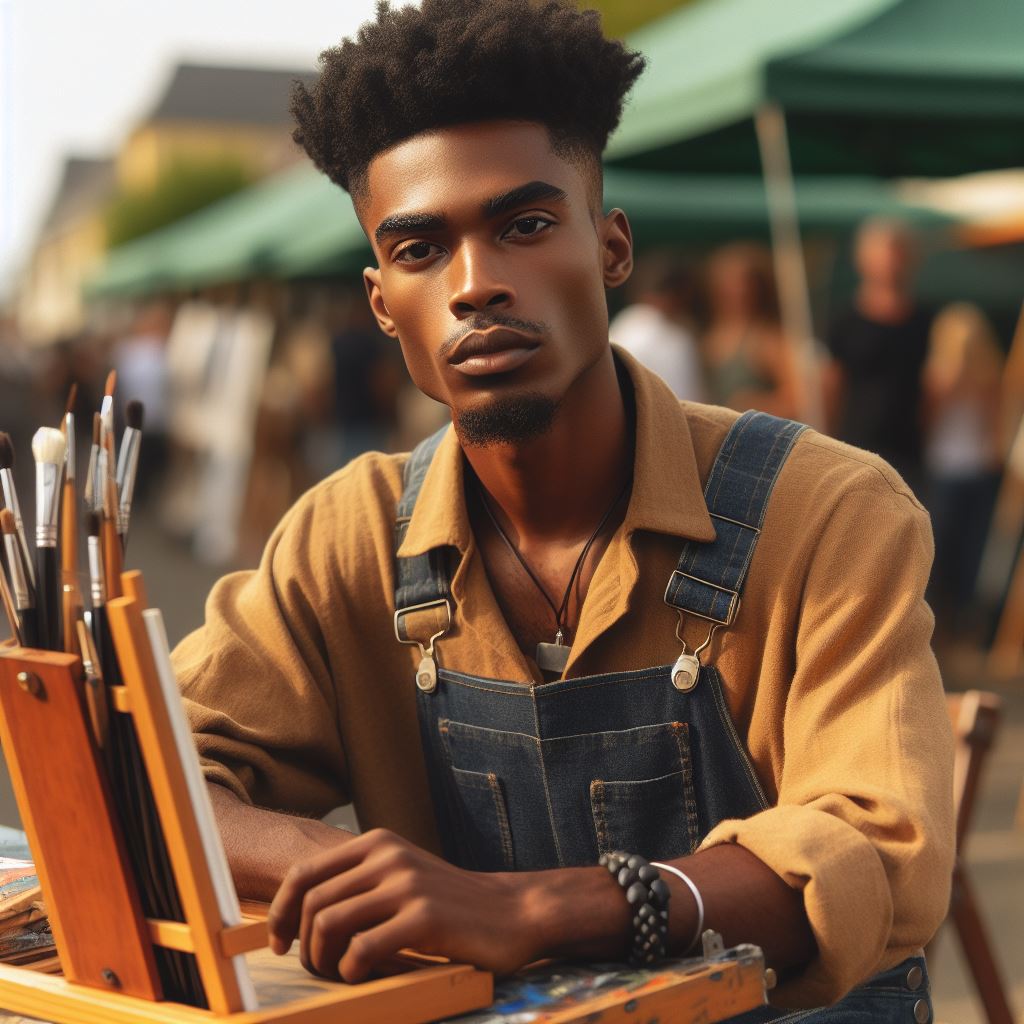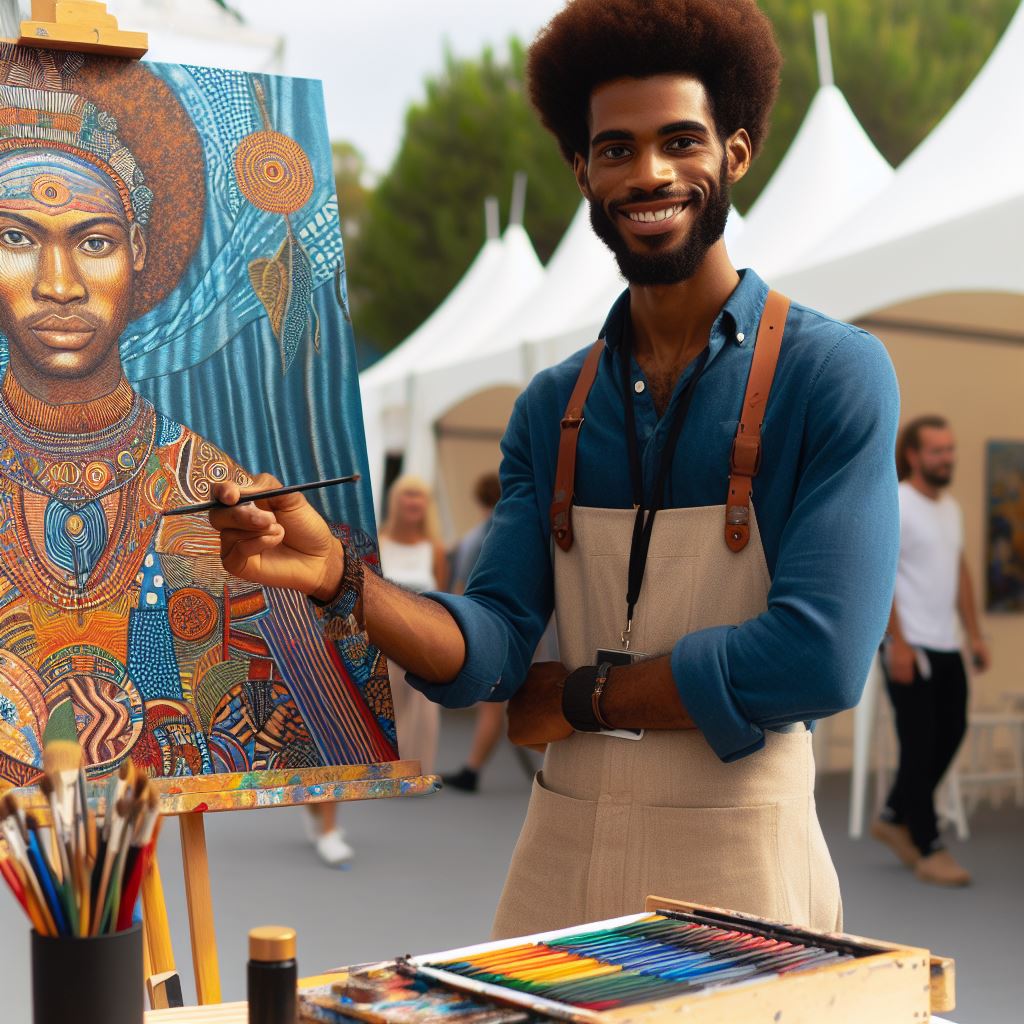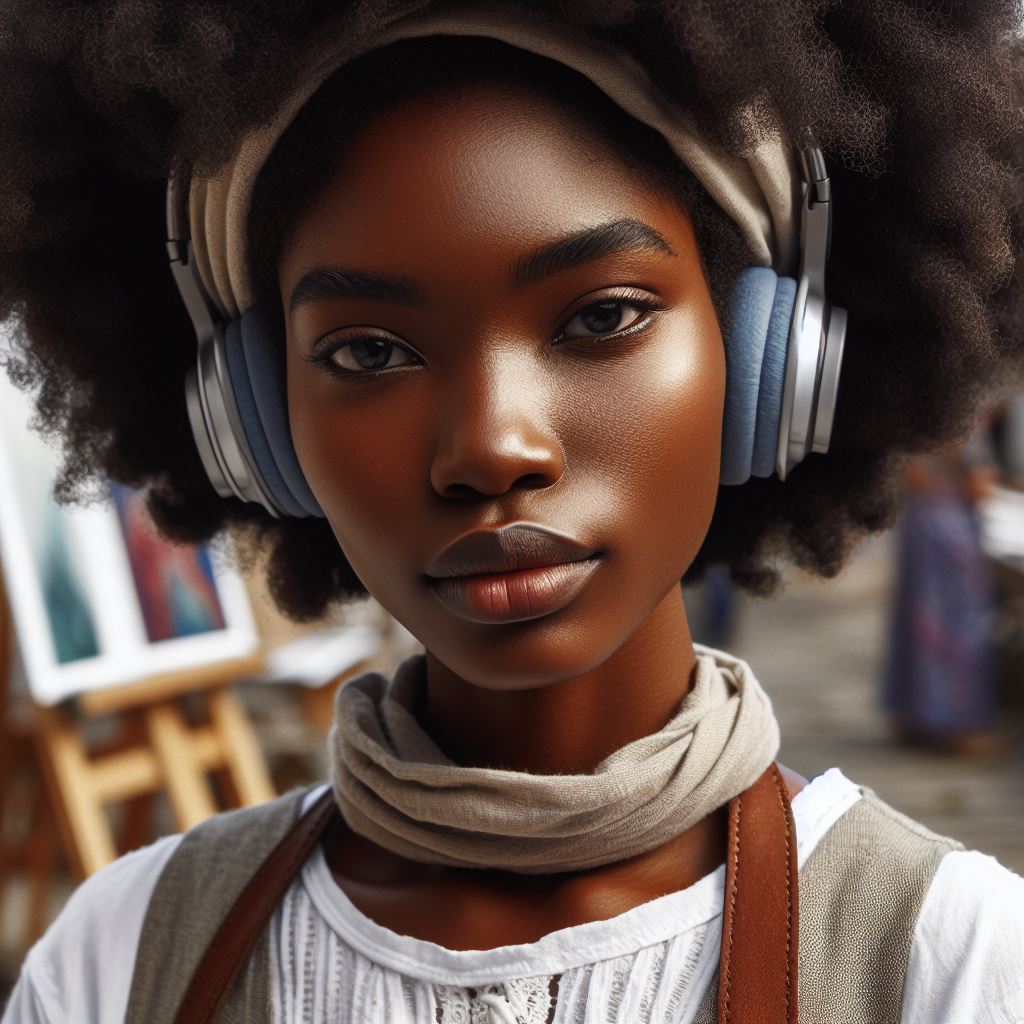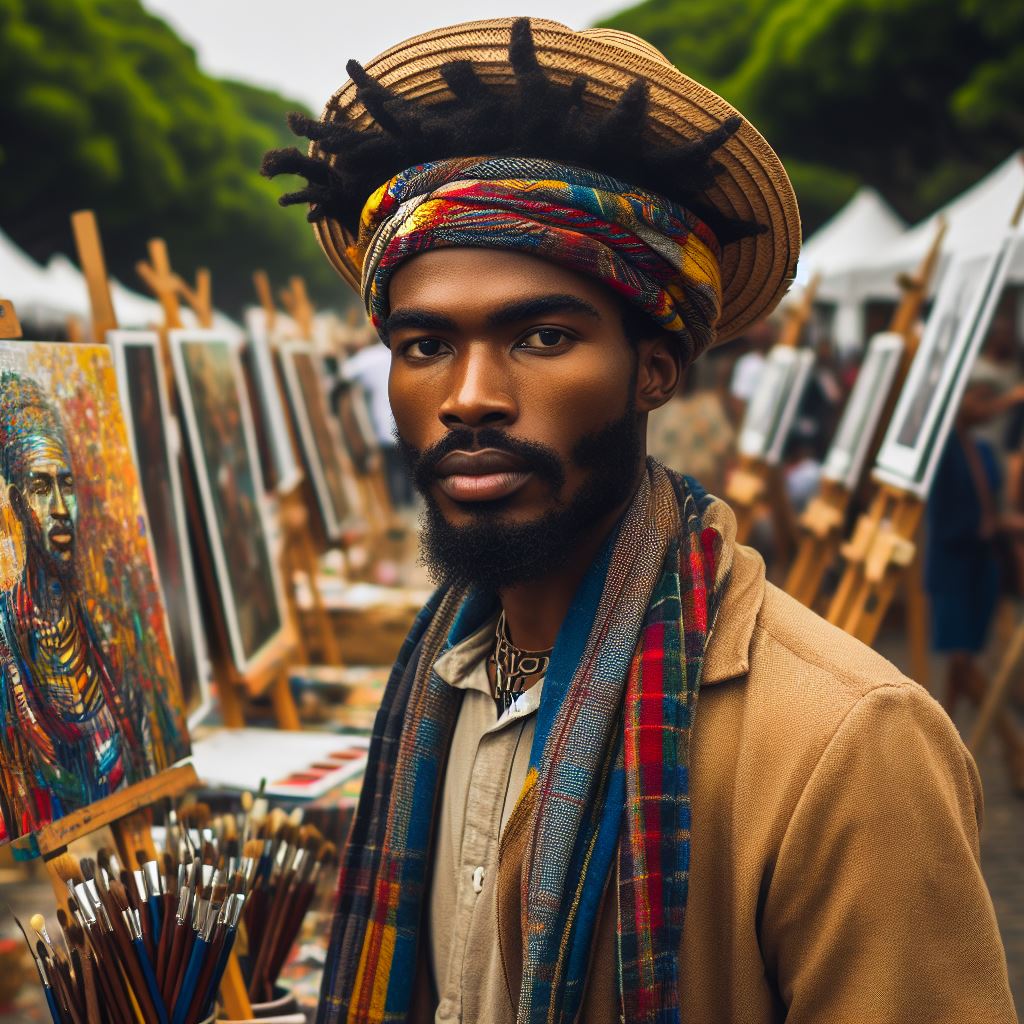Introduction
Nigerian art serves as a vibrant tapestry that intricately weaves together the diverse cultural heritage of the nation.
It embodies the essence of Nigeria’s multiethnic society, reflecting the traditions, beliefs, and values passed down through generations.
From ancient sculptures and traditional crafts to contemporary works of art, Nigerian art encapsulates the dynamic evolution of cultural expression over centuries.
At its core, Nigerian art is not merely a product of aesthetic creativity; it is a powerful medium for storytelling, social commentary, and identity formation.
Each piece of art carries within it layers of history, symbolism, and cultural significance, serving as a visual narrative of the Nigerian experience.
Nigeria’s diverse ethnic groups reveal beliefs, rituals, and worldviews through iconic Benin bronzes, Yoruba sculptures, and Igbo masks.
Moreover, Nigerian art is deeply rooted in oral traditions and communal practices, reflecting the interconnectedness of individuals within their communities.
Artists often draw inspiration from everyday life, mythology, folklore, and spiritual beliefs, infusing their works with a sense of authenticity and cultural resonance.
Examining Nigerian art reveals artistic techniques, stylistic influences, and societal norms, customs, and historical events.
Understanding Nigerian art holds immense importance in safeguarding cultural heritage from dilution or oblivion.
It serves as a bridge that connects the past with the present, fostering appreciation for the richness and diversity of Nigeria’s cultural landscape.
Engaging with Nigerian art deepens appreciation for its complexities, preserving and celebrating cultural heritage.
Traditional Nigerian art forms
Traditional Nigerian art forms encompass diverse expressions passed down through generations, rich in heritage.
These art forms play a significant role in reflecting the cultural heritage of Nigeria and preserving its traditions.
Description of traditional art forms
Traditional Nigerian art encompasses a variety of mediums, including pottery, sculpture, textiles, and masks.
Each of these art forms has its own unique characteristics and techniques that have been perfected over centuries.
- Pottery: Pottery making is a longstanding tradition in Nigeria, with artisans creating beautiful and functional vessels using clay.
These pots are often decorated with intricate patterns and designs, showcasing the artistic skill of the potter. - Sculpture: Sculpture is another important art form in Nigeria, with artists creating intricate sculptures out of wood, bronze, or terracotta.
These sculptures often depict traditional themes such as deities, ancestors, and mythical creatures. - Textiles: Textiles play a vital role in Nigerian culture, with artisans using traditional weaving and dyeing techniques to create vibrant and intricate fabrics.
These textiles are often used in clothing, ceremonies, and rituals. - Masks: Masks hold a special significance in Nigerian culture, with each mask representing a specific deity, ancestor, or spirit.
These masks are used in ceremonies, dances, and rituals to connect with the spiritual realm.
Role of traditional art in preserving cultural practices and beliefs
Traditional Nigerian art plays a crucial role in preserving cultural practices and beliefs by serving as a visual representation of the country’s heritage.
These art forms serve as a link to the past, allowing future generations to understand and appreciate their cultural roots.
- Preserving rituals: Many traditional Nigerian art forms are closely tied to rituals and ceremonies that have been practiced for centuries.
By creating art pieces that reflect these rituals, artists help to keep these traditions alive and pass them down to the next generation. - Promoting cultural identity: Traditional art forms serve as a powerful tool for promoting cultural identity and pride.
By showcasing the unique artistic traditions of Nigeria, artists celebrate their heritage and reinforce a sense of belonging among the people.
Examples of traditional Nigerian art pieces and their cultural significance
There are numerous examples of traditional Nigerian art pieces that hold great cultural significance.
These art pieces not only showcase the artistic skills of Nigerian artisans but also convey important cultural messages and beliefs.
- Nok terracotta figures: The Nok terracotta figures are one of the earliest forms of sculpture in Nigeria, dating back to around 500 BC.
These figures depict human and animal forms and are believed to represent ancestors or deities. - Adire textiles: Adire textiles are a type of traditional Nigerian textile that is dyed using indigo dye and resist dyeing techniques.
These textiles are often adorned with intricate patterns and designs and are worn during important cultural ceremonies. - Gelede masks: Gelede masks are used by the Yoruba people in southwestern Nigeria during ceremonies to honor female ancestors.
These masks feature elaborate designs and cowrie shell embellishments and are believed to protect the community from evil spirits. - Igbo-Ukwu bronze artifacts: The Igbo-Ukwu bronze artifacts are a collection of intricate bronze objects that date back to the 9th century.
These artifacts include ceremonial vessels, jewelry, and sculptures that showcase the advanced metalworking skills of the Igbo people.
Overall, traditional Nigerian art forms play a crucial role in reflecting the cultural heritage of Nigeria and preserving its rich traditions.
Through mediums such as pottery, sculpture, textiles, and masks, Nigerian artists continue to showcase their artistic talents and celebrate their cultural roots.
Read: Top Art Festivals Celebrated in Nigeria
Influence of Cultural Diversity on Nigerian Art
When it comes to Nigerian art, the influence of cultural diversity cannot be overstated.
Nigeria is a country with over 250 ethnic groups, each with its unique traditions, languages, and artistic expressions.
This diversity is a rich tapestry that is reflected in the country’s art scene.
Nigeria’s Diverse Cultural Groups
Nigeria is known for its cultural diversity, with diverse groups such as the Yoruba, Hausa, Igbo, and many more.
Each group has its own unique art forms, be it in sculpture, painting, music, dance, or storytelling.
Contribution to the Country’s Artistic Landscape
The various cultural groups in Nigeria contribute to the richness and vibrancy of the country’s artistic landscape.
They bring different perspectives, techniques, and themes to the table, creating a diverse tapestry of artistic expressions.
Coexistence of Various Ethnic Groups, Languages, and Traditions
Nigerian art reflects the coexistence of various ethnic groups, languages, and traditions.
Artists often draw inspiration from their cultural heritage, incorporating traditional motifs, symbols, and themes into their works.
Examples of Art Pieces Showcasing Cultural Diversity
The Nok Terracotta sculptures, which date back to 500 BC, showcase the artistic skills of ancient Nigerian civilizations.
The bronze sculptures of the Benin Kingdom, renowned for their intricate detailing and craftsmanship, highlight the cultural heritage of the Edo people.
The Adire textile art of the Yoruba people, known for its vibrant colors and intricate patterns, is a testament to the rich cultural traditions of the group.
The masquerade performances of various ethnic groups, such as the Igbo Mmanwu dance or the Yoruba Egungun festival, are vibrant displays of cultural heritage through art and performance.
In fact, cultural diversity is at the heart of Nigerian art. It is a rich and complex tapestry that reflects the country’s vibrant heritage, traditions, and identity.
Artists draw inspiration from their cultural roots, creating art that is not only visually captivating but also deeply meaningful and reflective of the diversity of Nigeria.
Read: Exploring the Nigerian Contemporary Art Scene

Symbolism and storytelling in Nigerian art
Nigerian art is rich in symbolism and storytelling techniques that serve as a reflection of the country’s cultural heritage.
Transform Your Career with Expert Guidance
Get personalized mentorship consulting that’s tailored to your unique path. Our expert advice is actionable and exclusive.
Get StartedArtists in Nigeria use various symbols and narratives to convey important cultural stories, historical events, and values to the audience.
Examination of the use of symbolism and storytelling techniques in Nigerian art
Symbolism in Nigerian art is deeply rooted in the country’s diverse culture and traditions.
Artists incorporate symbols such as animals, plants, colors, and motifs that hold specific meanings within Nigerian society.
These symbols help to convey powerful messages and emotions in art pieces.
Storytelling is another key aspect of Nigerian art that plays a significant role in preserving the country’s cultural heritage.
Through art, Nigerian artists tell stories of their ancestors, historical events, and everyday life in the country.
These narratives help to pass down important traditions and values from one generation to another.
How art pieces convey important cultural narratives, history, and values
Nigerian art pieces serve as a medium through which important cultural narratives, history, and values are communicated.
Each artwork tells a unique story that reflects the artist’s perspective on Nigerian society, traditions, and beliefs.
By analyzing these art pieces, viewers can gain a deeper understanding of Nigeria’s cultural heritage.
For example, the use of vibrant colors, intricate patterns, and symbolic motifs in Nigerian textiles and pottery signifies the country’s rich cultural history and traditions.
These art forms are often passed down through generations and hold a special significance in Nigerian society.
Analysis of specific Nigerian artworks that tell stories of the country’s heritage and traditions
There are numerous Nigerian artworks that effectively convey stories of the country’s heritage and traditions.
One such example is the widely acclaimed “Nok Terracotta Heads,” which date back to the Nok culture in Nigeria.
These ancient sculptures depict human heads with intricate facial features and serve as a representation of the artistic skills and cultural practices of the Nok people.
Similarly, contemporary Nigerian artists like Ben Enwonwu and Yusuf Grillo have created artworks that delve into Nigeria’s history, traditions, and societal issues.
Enwonwu celebrates the Igbo sun goddess with his famous sculpture “Anyanwu.” Grillo’s paintings capture Nigeria’s vibrant culture.
In short, symbolism and storytelling are integral components of Nigerian art that effectively reflect the country’s cultural heritage.
Nigerian artists employ symbols, narratives, and techniques to convey cultural stories, history, and values, preserving heritage.
They contribute to promoting Nigeria’s rich traditions.
Read: Art Collecting in Nigeria: A Beginner’s Guide
Modern interpretations of Nigerian art
Nigerian art has a rich history that dates back centuries, but it is also a vibrant and evolving form of expression that continues to adapt to the changing cultural landscape of the country.
Contemporary Nigerian artists actively blend traditional and modern styles, reflecting Nigeria’s diverse cultural heritage.
Overview of contemporary Nigerian artists
There are many talented artists in Nigeria who are redefining the boundaries of traditional art by incorporating modern elements into their work.
One such artist is Peju Alatise, whose sculptures and installations draw on Yoruba traditions while addressing contemporary social issues.
Another notable artist is Victor Ehikhamenor, whose intricate drawings and paintings reflect a fusion of Benin and European influences.
Use of traditional art forms in a modern context
Contemporary Nigerian artists often draw inspiration from traditional art forms such as mask-making, pottery, and textiles, and reinterpret them in a modern context.
These artists blend traditional techniques with contemporary styles, creating visually stunning, conceptually rich pieces bridging past and present.
This fusion of old and new allows them to explore themes of identity, heritage, and cultural evolution in innovative ways.
Examples of modern Nigerian art pieces
- Njideka Akunyili Crosby: Known for her intricate collages that combine elements of Nigerian and American culture, Crosby’s work challenges traditional notions of identity and belonging.
- Laolu Senbanjo: Senbanjo’s unique blend of Yoruba body painting and contemporary art has garnered international acclaim, with his intricate designs adorning the bodies of celebrities and appearing in museum collections.
- Ndidi Dike: Dike’s multimedia installations explore the intersection of traditional Nigerian symbols and contemporary issues, creating immersive experiences that engage viewers in a dialogue about the country’s past and present.
Read: Key Nigerian Art Exhibitions to Attend
Preservation and Promotion of Nigerian Art
Importance of preserving Nigerian art as a way to safeguard the country’s cultural heritage
Preserving Nigerian art is crucial as it serves as a reflection of the rich cultural heritage of the country.
It is through these artworks that future generations can learn about the traditions, beliefs, and values of the Nigerian people.
Art acts as a visual record of history, allowing us to understand and appreciate the diverse cultures that make up Nigeria.
By safeguarding Nigerian art, we are ensuring that these cultural narratives are not lost or forgotten over time.
Initiatives and organizations working to promote Nigerian art both locally and internationally
There are several initiatives and organizations dedicated to promoting Nigerian art on both local and international platforms.
One such organization is the Society of Nigerian Artists (SNA), which aims to support and showcase the work of Nigerian artists.
The SNA actively organizes exhibitions, workshops, and cultural events, fostering awareness about Nigerian art.
Artists seize networking opportunities, nurturing their craft.
Art galleries and museums nationwide actively collect and display Nigerian art, introducing it widely.
Ways in which individuals can support and engage with Nigerian art to ensure its preservation for future generations
- Attend art exhibitions and fairs showcasing Nigerian art to show support for local artists.
- Collect and display Nigerian art in your home or office to help promote the work of talented artists.
- Participate in art workshops and classes to learn more about Nigerian art techniques and styles.
- Support local art organizations and initiatives financially or through volunteer work to help nurture the next generation of Nigerian artists.
- Spread awareness about Nigerian art on social media and other platforms to educate others about the importance of preserving this cultural heritage.
Conclusion
Nigerian art serves as a visual storytelling of the country’s rich cultural heritage.
From traditional sculptures to contemporary paintings, Nigerian art reflects the diverse ethnic groups and traditions that make up the nation.
By appreciating and supporting Nigerian art, individuals can contribute to the preservation of the country’s cultural traditions.
Through understanding the significance of Nigerian art, we can gain insight into the history and values that have shaped the nation.
As we continue to explore the world of Nigerian art, let us engage in conversations, visit art galleries, and support local artists.
By doing so, we can enhance our own cultural literacy and promote the importance of preserving Nigeria’s artistic heritage for future generations.




